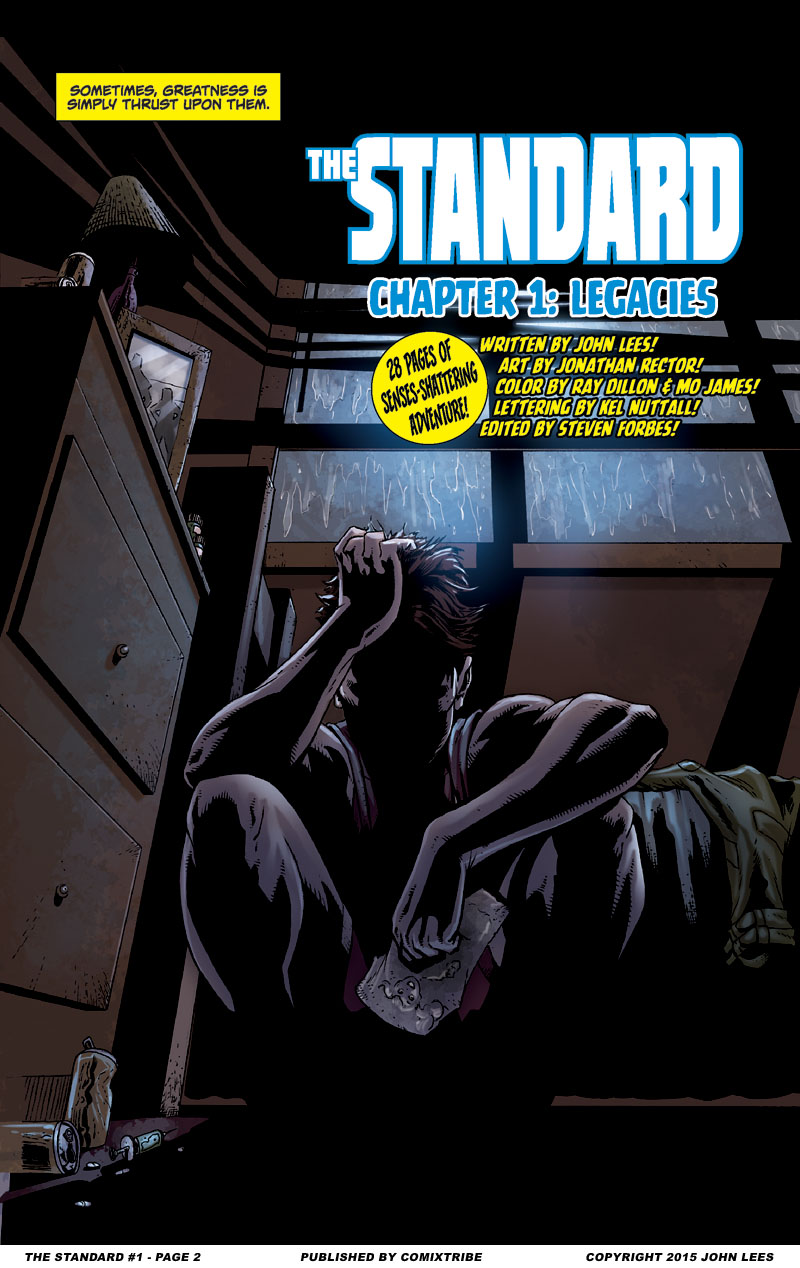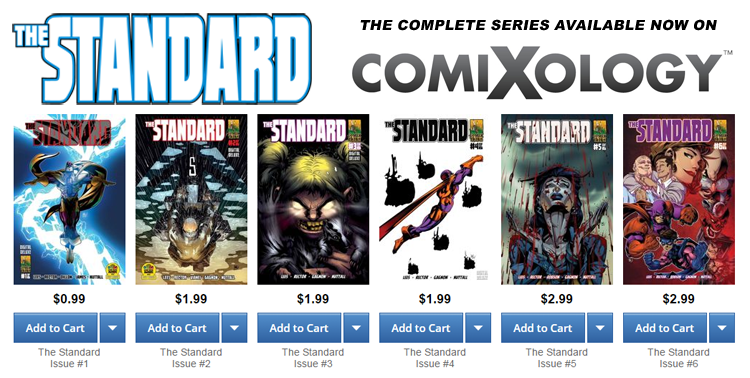Here is the first title/credits splash page of the series, which began the trend of Silver Age pastiches written in that old-school jovial huckster style Stan Lee did so well back in the 60s.
On the last page, I talked a little about how THE STANDARD first came to be, getting as far as the Proving Grounds. Editor Steven Forbes runs a column called the Proving Grounds on the ComixTribe website, where he edits and critiques submitted scripts. I remember seeing an ad for an earlier incarnation of this column on a message board, and, knowing I had THE STANDARD #1 sitting gathering dust, I figured there would be no harm in submitting it. At least I figured I could get some insight into where I was going wrong. Before submitting, though, I made sure to read through every previous edition of the Proving Grounds up until that point, to make sure I wasn’t repeating the mistakes of past candidates, and I also read through the entirety of Steve’s other column, Bolts & Nuts. Now, to anybody who is remotely interested in learning the craft of writing comics, I’d call Bolts & Nuts essential reading. I’d say that’s what pretty much taught me how to write comics, from being a total novice in the medium. With the wealth of newly acquired knowledge, and a bunch of adjustments to my script made in response, I submitted THE STANDARD #1 to the Proving Grounds, and anxiously awaited a response.
To discuss what happened from there, I thought it’d be good to chat to Steven Forbes. So here’s a little interview with the man himself:
JOHN LEES: First, as an intro, would you like to talk a little about what being a comics editor entails?
STEVEN FORBES: Patience. Lots and lots of patience. Lots of waiting, and then a flurry of activity and dealing with all of that, and then more waiting.Being an editor is a lot like being a hybrid of a traffic cop and cheerleader. You gotta give directions sometimes, you make sure things go as smoothly as possible, and you give encouragement, all at the same time.JL: Can you remember the first time I emailed you? I must have been pretty nervous in the message, as I seem to remember the first thing you said to me in your reply was, “I’m not an ogre.”SF: I faintly remember the first time John emailed me. I was running The Proving Grounds on a site called Project Fanboy (which has since turned into Fanboy Buzz), and I also had another column, Bolts & Nuts. Both columns were in their first iterations. John emailed me, wanting to submit a script to The Proving Grounds, but since it was the first comic script he’d ever written, he wondered if he should first read the Bolts & Nuts article.Now, I know what I would have done: I’d have read all the B&N articles first, and then made sure my script was as pristine as it could be before submitting it. That’s what I would have done, but that’s not something I could say. It had to be John’s own decision. So, I recall saying something like, “I know what I’d do, but what I would do isn’t necessarily what you would do. Not helpful, I know, but you have to make your own decision.”John decided to take what I believe is the smarter route, and he read all the B&N articles I had at the time, and then he reworked his script so that it conformed more to what I was expecting.I seem to recall John saying that he was very happy he had read the articles first, because he thought the work came out better for it.That first script was The Standard. The rest…is a story to tell. :rimshot:JL: What were your impressions of that first draft of THE STANDARD #1 when you read it for The Proving Grounds?SF: I didn’t understand what John was doing at first.The first part of the script was this modern tale, and then the next scene was this garishly old-time thing, and it went back and forth (and back and forth). I was losing my mind–how could this writer be simultaneously this good, and then this bad?!And then I got it! I understood that he was telling the story in two timeframes, and the writing reflected that.It was the first time I had read a Proving Grounds entry to the very end. I had had a lot of entries, and most of them were less than spectacular. The Standard, though, grabbed me. I even told my wife! She didn’t overly care, except that I was losing my mind for a different reason.I saw the potential in the story. I saw the potential in the writer. This was a story I felt needed to be told, and it was a story I wanted to be a part of.I emailed John and basically told him so, going so far as to give him a break on my rates in order to see the first issue come to fruition. I wanted to see this thing come to life!JL: What made you think that this was a comic project you’d be interested in editing?SF: It was the writing. Pure and simple.Here’s the thing (and John might find this embarrassing): John is a damned fine writer, and will be telling stories for Marvel or DC once they finally read the stories he writes. John is easily one of the strongest writers I know. He tells stories that are filled with real characters that you can connect with.When I finished reading that draft of The Standard, I was jealous. I wanted talent like that, dammit, and I wanted it now! It wasn’t right that a newcomer is able to write like this. I swear, it’s something in the water over there. Some writers owe me whiskey (true Scotch, here in the US), but from John, the only thing I want is for him to send me some water. Hopefully, some of that genius will filter in to me.JL: When you came onboard as editor, I had no real idea of format. I’d written a first issue, and had no real notion of where to go next beyond vague ongoing aspirations, if I recall. You asked me to send you an outline of the whole series, with a beginning, middle and end, and I came back with an 8-part outline. You then asked me to whittle it down to 6, which I did, and we worked from there. As an editor, do you find helping to hammer down the format of a writer’s story is something you have to do often? Or do writers tend to come to you with things like structure more fully-formed?SF: Writers tend to come to me with a structure already formatted, if it’s a multi-part story. If they want me over the life of the story, then we’ll talk about format, and what works best for the story. There are a couple of reasons for this.Sometimes, writers try to put too much stuff in, and that dilutes the story. Whittling a story down tends to cut the fat.The biggest reason, though, is purely financial. Writers are usually the ones paying to get the story created. Paying several thousand dollars per issue isn’t anyone’s idea of a good time, so I try to make sure that the story is able to be told in as few parts as possible.For The Standard, I suggested to John to lower the number of issues, but to raise the page count a bit. This would have the effect of giving more story for the price of the comic, cutting some of the fat, while still lowering the overall cost of creation. It was win-win-win.JL: You came onboard as editor in early 2009. After sorting out the series outline and the chapter outlines within that, and doing script revisions on the first issue, by the summer of 2009 we began looking for an artist. What are your memories of that artist search?SF: I remember saying that, in a perfect world, I wanted to have two artists work on the book: one for the “present”, and one for the “past.” I thought that that would set the book off perfectly.John was resistant to that idea, and I understood it. I wouldn’t want to pay two different artists, myself. Unfortunately, artists are known to flake out and not do the work much more than any other part of the creative team.I also wanted to work very badly with Ray Dillon. Ray is an artist extraordinaire, and I had been wanting to do work with him for years. Things just never came together. Well, I suggested Ray for that first issue, and then when John saw what Ray could do (pencils, inks, coloring and letters), John was pretty much for him.(JOHN’S NOTE: We ended up picking someone else over Ray as the original artist for the book, though Ray was on the final shortlist. Ray did, however, end up coming onboard as colorist for the first issue, which we’ll hopefully get to talk a bit more about later.)JL: And, of course, it was you who discovered Jonathan Rector in the end. Can you remember how you first came across him, and what it was about his style that made you think he’d be a good fit for THE STANDARD?SF: I honestly don’t remember finding Jon. We had gone through a lot of artists, and I knew that I wanted a signature look for The Standard, a departure from the style of our previous artist, but also building upon it. Something dynamic. Jon Rector came up with all of that in spades. And each issue, he only got better! It was truly awesome to see! I honestly believe that some of the pages and covers he drew should be posters and t-shirts.
A big thanks to Steven for taking the time to share his memories of the early days of THE STANDARD. I’m sure we’ll get the chance to talk to him more later.






Discussion ¬